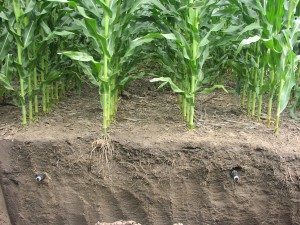Subsurface Drip Irrigation Isn’t Rocket Science – But It Requires Management
Exerpt from “Subsurface drip irrigation: Battling drought, water restrictions, and declining groundwater” by Tanner Ehmke, contributing writer for Crops & Soils magazine.
 With drought gripping much of the Great Plains and western states, and with groundwater reserves declining and water regulations increasing, growers and their CCAs are finding ways to get more crop per drop with precision irrigation.
With drought gripping much of the Great Plains and western states, and with groundwater reserves declining and water regulations increasing, growers and their CCAs are finding ways to get more crop per drop with precision irrigation.
Starting in 1993, CCA Bill Cox, agricultural consultant at CoxCo Ag Services in Las Cruces, NM, has helped his clients convert thousands of acres of center-pivot irrigation to the more water-efficient subsurface drip irrigation (SDI) systems, in which buried drip lines below the soil surface deliver water and nutrients directly to the plant’s root zone with minimal losses to surface evaporation or deep percolation.
With SDI, Cox’s growers are able to sharply reduce waste compared with other irrigation systems like furrow and center-pivot irrigation. That enables his growers to put more water to use for crop production, he says. But don’t confuse water use efficiency with water conservation, Cox stresses. The goal isn’t necessarily to use less water, but to get more production with the water that you have.
“Does drip irrigation save you water? My answer to that is it doesn’t,” he says. “[The crop] still uses the same amount of water it did before you switched to drip. The difference is you’re eliminating the waste. And if you can retrieve that waste, you’re able to farm a lot more acres with the same amount of water you were using before. You just diverted it. You’re putting it somewhere else to grow something with it.”
With furrow irrigation, Cox’s growers were only able to achieve up to 50% efficiency, meaning half of the water pumped on the field contributed to crop production while the other half was lost mostly to evaporation. But with SDI, his clients now achieve 90 to 95% efficiency, he says.
However, proper management prolongs the life of the system (some drip lines can last over 25 years). That’s where CCAs are important. With technology evolving and water issues becoming more complex, growers will need informed and educated CCAs to help coordinate crop rotations, schedule irrigation, and manage fertility programs. The CCA’s role in states experiencing increased fertilizer regulation will be particularly important in advising clients on nutrient management plans.
Click to read the full article: Subsurface drip irrigation: Battling drought, water restrictions, and declining groundwater